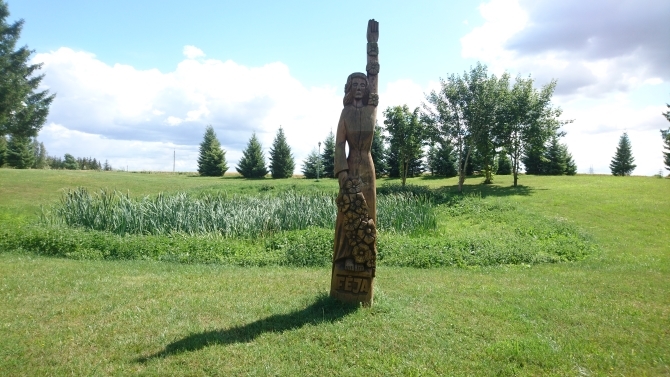
Lietuvių:
Pasvalyje karstiniame slėnyje įsikūręs vienintelis pasaulyje smegduobių parkas.
Dalį šio karstinio slėnio Parsvalyje pavertė apie 8 hektarų parku, kuriame, be smegduobių, įrengtas teatras po atviru dangumi, riedlenčių trasa, medinių skulptūrų parkas. Be to, įrengtas paminklas vienam didžiausių Lietuvos poetų, įrengta žaidimų aikštelė ir treniruokliai.
Informacinė lenta apie „smegduobių“ reiškinį ir jo įtaką Pasvalyje yra N 56° 03.383 E 024°23.859.
Ant nedidelės kalvos, esančios parko pakraštyje, regioniniai medžio meistrai pastatė 7 šventųjų statulas. Šie šventieji saugo smegduobių parko lankytojus.
Informacija apie smegduobę:
Smegduobės gali atsirasti tose vietose, kur požemyje yra tirpių uolienų, pavyzdžiui, druskos ir kalkių. Druska yra lengvesnė už aplinkinę uolą ir stumiama aukštyn. Kai ta druska pasiekia požeminį vandenį, ji ištirpsta, su tuo vandeniu nusausinama ir po žemės pluta pamažu susidaro didelė skylė. Sugriuvus žemės plutai, išryškėja smegduobė.
Dažniausios smegduobės yra smegduobės. Tai smegduobės, susidariusios kalkakmeniui ištirpus vandenyje (karstui). Tai gali būti požeminis vanduo, tekantis per dirvožemį išilgai įtrūkusių paviršių ar žemės plyšių, lietaus vanduo, prasiskverbęs į žemę arba vanduo, pavyzdžiui, iš sutrūkusių vamzdžių ir kanalizacijos.
Linijos:
Smegduobė turi du išvaizdus: paviršinę formą (kraštovaizdžio nuolydis) ir įdubusią formą (skylė). Abu atsiranda dėl kalkakmenio ištirpimo dėl (rūgštaus) lietaus. (Karstas)
Smegduobė gali susidaryti dviem būdais: vietiniu stipriu atmosferos poveikiu paviršiuje dėl rūgštaus lietaus arba (daliniu) požeminio urvo griūtimi.
Dolines gali užaugti iki dešimčių metrų dydžio. Kai kelios gretimos dolinos susilieja viena į kitą, tai vadinama karstiniu slėniu.
Kadangi smegduobės yra kraštovaizdžio įdubos, jos surenka lietaus vandenį. Kai formuojantis smegduobei ištirpsta kalkakmenis, lieka molingos nuosėdos, galinčios gerai sulaikyti lietaus vandenį. Drėgnas molio dirvožemis yra daug geresnis augalijai nei aplinkinis kalkinis dirvožemis. Todėl sijos kartais naudojamos žemdirbystei gana sausuose regionuose.
Kadangi augalija papildomai rūgština požeminį kalkakmenį, gali susidaryti karstiniai vamzdžiai.
Šaltinis:
https://tic.visitpasvalys.lt/lt/zemelapis/?o=18212
https://www.vrt.be/vrtnws/nl/2017/09/07/wat-is-een-zinkgat-en-hoe-ontstaat-het-/
https://www.quest.nl/natuur/geologie/a42618640/hoe-ontstaat-zinkgaten/
https://nl.wikipedia.org/wiki/Zinkgat
https://nl.wikipedia.org/wiki/Karstpipe
Paklausti:
1) Kaip vadinamas kalkakmenio tirpimas vandenyje?
2) Kaip vadinamos dažniausiai pasitaikančios smegduobės?
3) Ar manote, kad ateityje šiame parke atsiras daugiau smegduobių ir kodėl?
Apsilankykite informacinėje lentoje ir peržiūrėkite toliau pateiktas nuotraukas.
4) Kas įkrito į smegduobę trečioje ir ketvirtoje informacinės lentos nuotraukose?
5) Nufotografuokite bent 3 medines šventųjų statulas ir ką nors iš savęs, kas susiję su geocachingu.
Atminkite, kad tai nėra egzaminas, tikslas yra tik priversti jus susimąstyti apie tai, kas vyksta čia, ir kokios yra matomos pasekmės.
Atsakymus siųskite mums per pranešimų centrą.
Rąstai negavus atsakymų ar be nuotraukos bus ištrinti be konsultacijos.

English:
The world's only sinkhole park is located in Pasvalyje in a karst valley.
Parsvalyje has turned part of this karst valley into a park of approximately 8 hectares where, in addition to the sinkholes, an open-air theater, a skating rink and a wooden sculpture park have been placed. In addition, a monument to one of Lithuania's greatest poets, playground equipment and fitness equipment have been installed.
An information board about the phenomenon of 'sinkholes' and its influence on Pasvalyje can be found at N 56° 03.383 E 024°23.859.
On a small hill at the edge of the park, regional woodworkers have placed 7 statues of saints. These saints protect visitors to the sinkhole park.
Sinkhole information:
Sinkholes can occur in places where there is soluble rock in the subsurface, such as salt and lime. Salt is lighter than the surrounding rock and is pushed up. When that salt reaches the groundwater, it dissolves, is drained away with that water and slowly creates a large hole under the earth's crust. When the earth's crust collapses, the sinkhole becomes visible.
The most common sinkholes are dolines. These are sinkholes that were created by the dissolution of limestone in water (karst). This could be groundwater that flows through the soil along fracture surfaces or cracks in the ground, rainwater that seeps into the ground or water from, for example, broken pipes and sewers.

Dolines:
A sinkhole has two appearances, a superficial shape (slope in the landscape) and a sunken shape (hole). Both are caused by the dissolution of limestone by (acid) rain. (Karst)
There are two ways in which a sinkhole can be formed, either by local strong weathering at the surface due to acid rain or by the (partial) collapse of an underlying cave.
Dolines can grow up to tens of meters in size. When several adjacent dolines merge into each other, it is called a karst valley.
Because sinkholes are hollows in the landscape, they collect rainwater. When limestone dissolves during the formation of the sinkhole, a clayey residue is left behind that can retain rainwater well. The moist clay soil is a much better soil for vegetation than the surrounding lime soil. Dolines are therefore sometimes used for arable farming in relatively dry regions.
Since vegetation has an additional acidifying effect on the underlying limestone, karst pipes can form.
Source:
https://tic.visitpasvalys.lt/lt/zemelapis/?o=18212
https://www.vrt.be/vrtnws/nl/2017/09/07/wat-is-een-zinkgat-en-hoe-ontstaat-het-/
https://www.quest.nl/natuur/geologie/a42618640/hoe-ontstaat-zinkgaten/
https://nl.wikipedia.org/wiki/Zinkgat
https://nl.wikipedia.org/wiki/Karstpipe
Questions:
1) What is the dissolution of limestone in water called?
2) What are the most common sinkholes called?
3) Do you think this park will see more sinkholes in the future and why?
Visit the information board and view the photos below.
4) What has fallen into a sinkhole in the third and fourth photo on the information board?
5) Take a photo of at least 3 wooden statues of saints and something of yourself that has to do with geocaching.
Remember that this is not an exam, the aim is merely to get you thinking about what is happening here on the ground and what the visible consequences are.
Send us the answers to the questions via the message center.
Logs without receiving answers or without a photo will be deleted without consultation.
